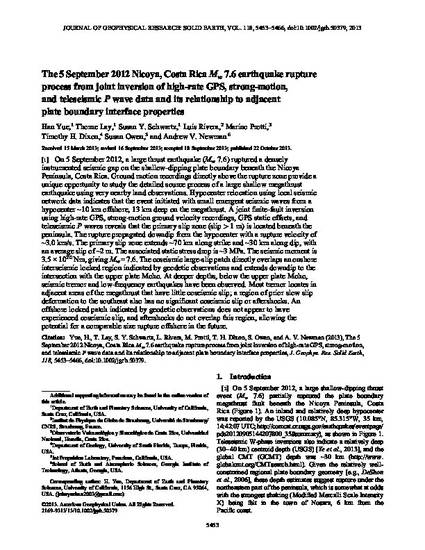
- 2012 Costa Rica earthquake,
- Seismic/Geodetic joint inversion,
- Finite fault model,
- Hypocenter relocation
On 5 September 2012, a large thrust earthquake (Mw 7.6) ruptured a densely instrumented seismic gap on the shallow‐dipping plate boundary beneath the Nicoya Peninsula, Costa Rica. Ground motion recordings directly above the rupture zone provide a unique opportunity to study the detailed source process of a large shallow megathrust earthquake using very nearby land observations. Hypocenter relocation using local seismic network data indicates that the event initiated with small emergent seismic waves from a hypocenter ~10 km offshore, 13 km deep on the megathrust. A joint finite‐fault inversion using high‐rate GPS, strong‐motion ground velocity recordings, GPS static offsets, and teleseismic P waves reveals that the primary slip zone (slip > 1 m) is located beneath the peninsula. The rupture propagated downdip from the hypocenter with a rupture velocity of ~3.0 km/s. The primary slip zone extends ~70 km along strike and ~30 km along dip, with an average slip of ~2 m. The associated static stress drop is ~3 MPa. The seismic moment is 3.5 × 1020 Nm, giving Mw = 7.6. The coseismic large‐slip patch directly overlaps an onshore interseismic locked region indicated by geodetic observations and extends downdip to the intersection with the upper plate Moho. At deeper depths, below the upper plate Moho, seismic tremor and low‐frequency earthquakes have been observed. Most tremor locates in adjacent areas of the megathrust that have little coseismic slip; a region of prior slow slip deformation to the southeast also has no significant coseismic slip or aftershocks. An offshore locked patch indicated by geodetic observations does not appear to have experienced coseismic slip, and aftershocks do not overlap this region, allowing the potential for a comparable size rupture offshore in the future.
Journal of Geophysical Research: Solid Earth, v. 118, issue 10, p. 5453-5466
©2013. American Geophysical Union. All Rights Reserved.
Available at: http://works.bepress.com/timothydixon/149/
